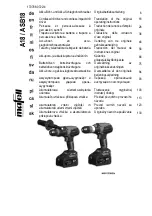
4. INSTRUCTIONS FOR APPLICATION
p
p
WARNING! ensure you wear approved safety goggles and any other safety items required for the job. If using conventional chuck,
remove the chuck key before using the drill. Also ensure that all other safety requirements are followed.
p
p
WARNING! In all cases below, be prepared for drill binding or break through. When these situations occur the drill has a tendency
to grab and kick in the opposite direction and could cause loss of control. If you are not prepared this can result in possible damage
and/or personal injury. Where possible, place a wooden block under metal work piece at the point where the drill will break through.
4.1.
DRILLING MASONRY, BRICK, STONE, ROCK OR CONCRETE.
The hammer action can be used if required on brick, stone, rock or concrete.
4.1.1. Ensure drill is unplugged from the mains power supply.
4.1.2. Place the dust cup on the drill piece.
4.1.3. If the material to be drilled is not fixed in place, it should be secured in a vice or with clamps to keep it from turning as the drill bit rotates.
4.1.4. If the surface is smooth, create a guide groove at the point of hole location. This will prevent bit from slipping as you start to drill.
Alternatively, drill a pilot hole to assist the final drill size through the work piece. Lock a pilot drill into the chuck (a smaller size drill than
finished hole size, you may need to use standard chuck), and drill a pilot hole. Insert the final sized bit into appropriate chuck or locking
collar. In addition to other safety items also wear an appropriate dust mask.
4.1.5. To increase drill penetration switch the hammer action on. Set the control selectors according to fig.3-X.
4.1.6. Plug drill into mains power supply and hold drill firmly, placing the bit at the entrance of the pilot hole, or at the point to be drilled.
4.1.7. Depress the trigger to start drill. Move the drill bit into the work piece applying only enough pressure to keep the bit cutting.
DO NOT force the drill or apply side pressure to elongate the hole. Allow the hammer action to progress the hole.
Occasionally remove the drill to expel dust from the hole.
4.1.8. If the bit jams in the work piece or if the drill stalls, release the trigger immediately. Remove the bit from the work piece and determine
the reason for jamming.
4.1.9. The depth gauge may be used to pre-determine the depth of hole.
4.2.
CHISEL .... USE on MASONRY, BRICK, STONE, ROCK OR CONCRETE.
p
p
WARNING! DO NOT USE DRILL MODE, use hammer action only. DO NOT USE WITH CONVENTIONAL CHUCK.
4.2.1. Ensure drill is unplugged from the mains power supply.
4.2.2. Place the dust cup on the chisel bit.
4.2.3. Set the control selectors according to fig.3-Y
4.2.4. Plug drill into mains power supply and hold drill firmly placing the chisel bit on the area of proposed impact.
4.2.5. Depress the trigger to start and progress the task accordingly.
4.3.
DRILLING WOOD AND PLASTIC.
DO NOT use the hammer action when drilling wood or plastic materials.
4.3.1. Ensure drill is unplugged from the mains power supply.
4.3.2. If the material to be drilled is not fixed in place, it should be secured in a vice or with clamps to keep it from turning as the drill bit rotates.
4.3.3. A pilot hole may be necessary to assist the final drill size through the work piece.
SDS850 - (1) - 13/03/03
fig 3
3.3.
SELECTION OF OPERATIONAL MODES
3.3.1
Control of hammer action.
The hammer action can be switched on or off by means of the lever selector on the back of the drill
(See fig.1-8). With the selector in the 9 oclock position the hammer action is active. With the selector in the 3 oclock position the
hammer action is off.
3.3.2
Rotation on/off selection.
The rotation on/off selector knob situated on the side of the drill (see fig.1-7) is used to deactivate the
rotation of the drill when the unit is to be used with a chisel, where only the hammer action is required. With the knob pointing to the
left the drill bit will be rotated. With the knob pointing to the right, rotation is deactivated.
3.3.3
These two controls are used
in combination to select the
three operational modes of
the drill as shown in fig.3.
3.3.4
Drill with hammer action.
Position both selectors as
shown in fig.3-X
3.3.5
Hammer action only.
(For use with a chisel)
Position both selectors as
shown in fig.3-Y
3.3.6
Drill without hammer action.
Position both selectors as
shown in fig.3-Z
3.2.
FITTING THE CONVENTIONAL DRILL CHUCK (See fig.2-D)
p
p
WARNING! Unplug from the mains power supply before assembling chuck.
3.2.1. Fit the conventional drill chuck (fig.2-F) by screwing it onto chuck spindle (E). Open chuck jaws and lock the chuck with screw (G).
NOTE: The screw has a left-hand thread and must be turned anti-clockwise to tighten.
3.2.2. Fit the chuck spindle (E) into the spindle lock as decribed in section 3.1.2.
3.2.3. Insert the drill bit into the three jaw chuck ensuring that it is centrally located and fully tighten with the chuck key.
p
WARNING! ensure you remove the chuck key before starting the drill.
s
s
CAUTION! To avoid overloading the motor when using the chuck in the hammer mode, DO NOT apply a too heavy pressure.
DO NOT USE CHISELS OR HAMMER MODE ONLY when using the conventional chuck, as chuck will be damaged.






















